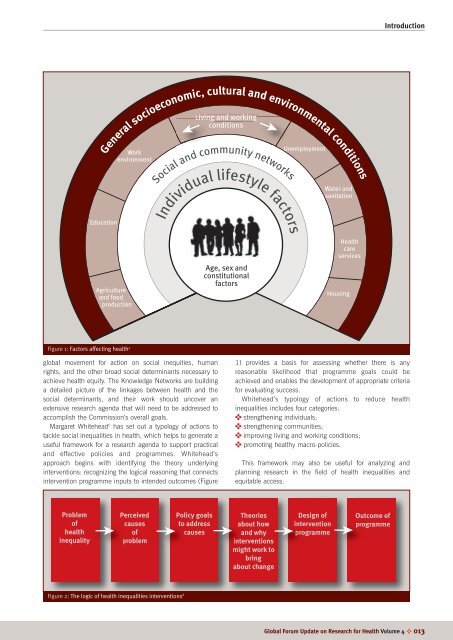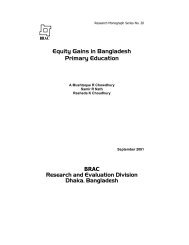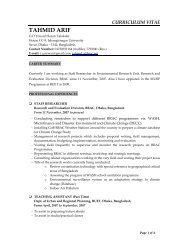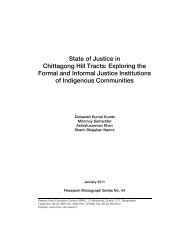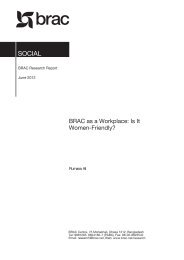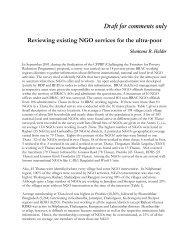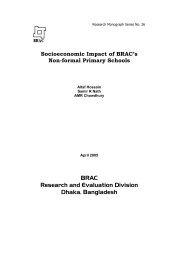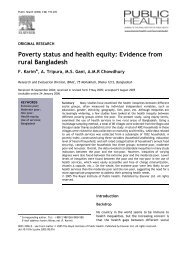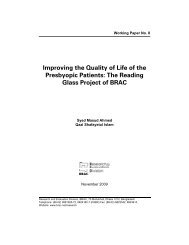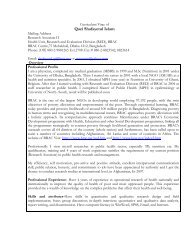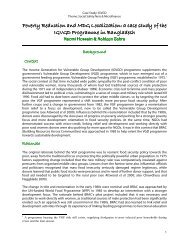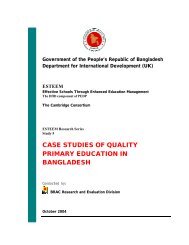Combining health and social protection measures to reach the ultra ...
Combining health and social protection measures to reach the ultra ...
Combining health and social protection measures to reach the ultra ...
Create successful ePaper yourself
Turn your PDF publications into a flip-book with our unique Google optimized e-Paper software.
Introduction<br />
Living <strong>and</strong> working<br />
conditions<br />
General socioeconomic, cultural <strong>and</strong> environmental conditions<br />
Work<br />
environment<br />
Unemployment<br />
Social <strong>and</strong> community networks<br />
Water <strong>and</strong><br />
sanitation<br />
Education<br />
Individual lifestyle fac<strong>to</strong>rs<br />
Agriculture<br />
<strong>and</strong> food<br />
production<br />
Age, sex <strong>and</strong><br />
constitutional<br />
fac<strong>to</strong>rs<br />
Health<br />
care<br />
services<br />
Housing<br />
Figure 1: Fac<strong>to</strong>rs affecting <strong>health</strong> 4<br />
global movement for action on <strong>social</strong> inequities, human<br />
rights, <strong>and</strong> <strong>the</strong> o<strong>the</strong>r broad <strong>social</strong> determinants necessary <strong>to</strong><br />
achieve <strong>health</strong> equity. The Knowledge Networks are building<br />
a detailed picture of <strong>the</strong> linkages between <strong>health</strong> <strong>and</strong> <strong>the</strong><br />
<strong>social</strong> determinants, <strong>and</strong> <strong>the</strong>ir work should uncover an<br />
extensive research agenda that will need <strong>to</strong> be addressed <strong>to</strong><br />
accomplish <strong>the</strong> Commission’s overall goals.<br />
Margaret Whitehead 6 has set out a typology of actions <strong>to</strong><br />
tackle <strong>social</strong> inequalities in <strong>health</strong>, which helps <strong>to</strong> generate a<br />
useful framework for a research agenda <strong>to</strong> support practical<br />
<strong>and</strong> effective policies <strong>and</strong> programmes. Whitehead’s<br />
approach begins with identifying <strong>the</strong> <strong>the</strong>ory underlying<br />
interventions: recognizing <strong>the</strong> logical reasoning that connects<br />
intervention programme inputs <strong>to</strong> intended outcomes (Figure<br />
1) provides a basis for assessing whe<strong>the</strong>r <strong>the</strong>re is any<br />
reasonable likelihood that programme goals could be<br />
achieved <strong>and</strong> enables <strong>the</strong> development of appropriate criteria<br />
for evaluating success.<br />
Whitehead’s typology of actions <strong>to</strong> reduce <strong>health</strong><br />
inequalities includes four categories:<br />
✜ streng<strong>the</strong>ning individuals;<br />
✜ streng<strong>the</strong>ning communities;<br />
✜ improving living <strong>and</strong> working conditions;<br />
✜ promoting <strong>health</strong>y macro-policies.<br />
This framework may also be useful for analyzing <strong>and</strong><br />
planning research in <strong>the</strong> field of <strong>health</strong> inequalities <strong>and</strong><br />
equitable access.<br />
Problem<br />
of<br />
<strong>health</strong><br />
inequality<br />
Perceived<br />
causes<br />
of<br />
problem<br />
Policy goals<br />
<strong>to</strong> address<br />
causes<br />
Theories<br />
about how<br />
<strong>and</strong> why<br />
interventions<br />
might work <strong>to</strong><br />
bring<br />
about change<br />
Design of<br />
intervention<br />
programme<br />
Outcome of<br />
programme<br />
Figure 2: The logic of <strong>health</strong> inequalities interventions 8<br />
Global Forum Update on Research for Health Volume 4 ✜ 013


